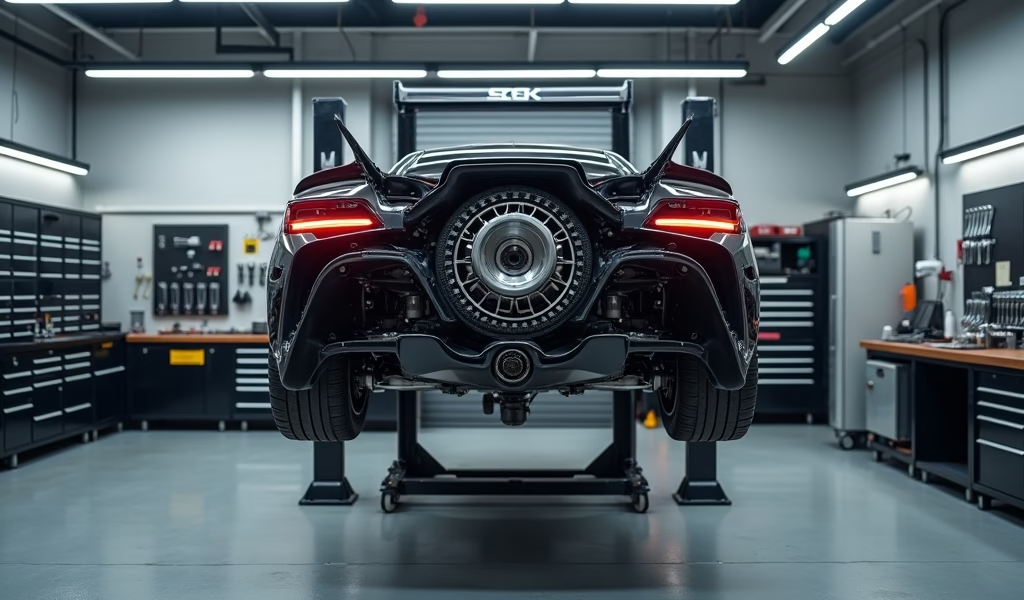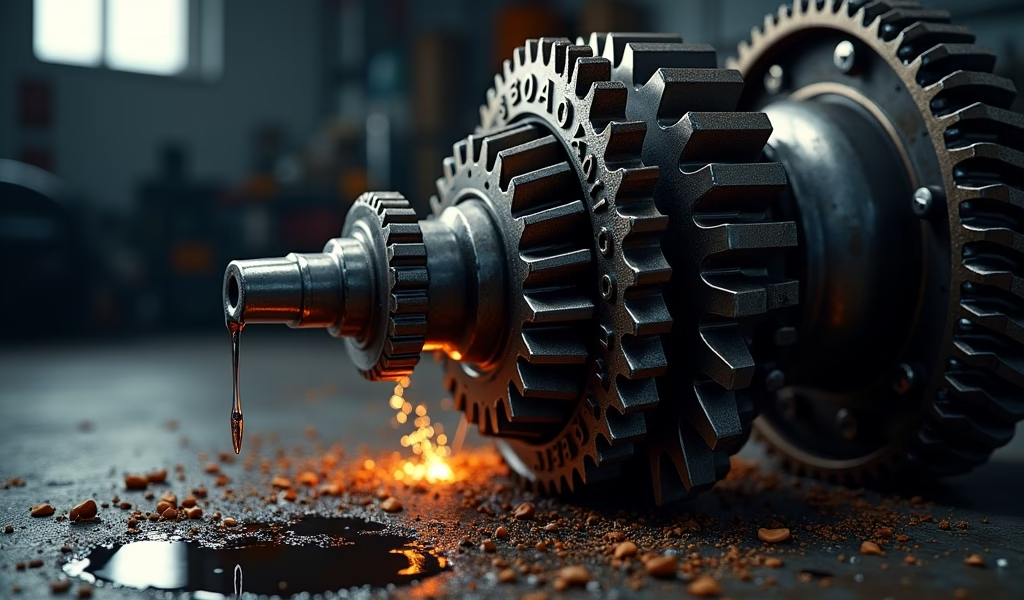Overview
This detailed guide explains how to properly measure and adjust ring and pinion backlash in vehicle differentials, emphasizing that correct backlash (typically 0.005″-0.015″) is crucial for preventing noise, reducing wear, and ensuring longevity. It covers the necessary tools, step-by-step measurement techniques, adjustment methods for different differential types, gear pattern checking, common mistakes to avoid, and troubleshooting tips for various backlash-related issues.
Table of Contents
- Understanding Backlash: What It Is and Why It Matters
- The Importance of Proper Backlash in Your Differential
- Tools You’ll Need for Backlash Adjustment
- Measuring Backlash: A Step-by-Step Guide
- Techniques for Adjusting Ring and Pinion Backlash
- Gear Pattern Checking: The Critical Companion to Backlash
- Common Mistakes to Avoid During Backlash Adjustment
- Troubleshooting Ring and Pinion Backlash Issues
- Conclusion
- Frequently Asked Questions
Understanding Backlash: What It Is and Why It Matters
Ring and pinion backlash is one of those technical terms that might sound intimidating, but it’s actually a straightforward concept that’s crucial to your vehicle’s differential health. In simple terms, backlash is the small gap between the ring gear and pinion gear teeth when they’re meshed together in your differential.
Think of backlash as the breathing room your gears need to function properly. This tiny space—typically measured in thousandths of an inch—allows for thermal expansion, proper lubrication flow, and smooth operation as your differential transfers power from your driveshaft to your wheels.
When I first started working on differentials twenty years ago, I quickly learned that backlash isn’t just some arbitrary measurement. It’s the heartbeat of your differential’s operation. Get it right, and your differential will purr along for thousands of miles. Get it wrong, and you’ll be hearing about it—literally—as your gears complain with whines, clunks, and potentially catastrophic failures.
Most vehicle manufacturers specify a backlash range between 0.005″ and 0.015″, though the exact specification varies by differential gear ratio and design. This seemingly microscopic space makes all the difference in how your differential performs and how long it lasts.
The Importance of Proper Backlash in Your Differential
Imagine dancing with a partner who’s either squeezing you too tightly or standing too far away. Either way, the dance won’t go smoothly—and your differential feels the same way about improper backlash.
When backlash is too tight (below specification), your gears generate excessive heat from the increased friction. This heat can break down your gear oil, accelerate wear patterns, and in extreme cases, cause the gears to seize or weld together under load. I’ve seen differentials with insufficient backlash that literally cooked themselves to death after just a few thousand miles.
On the flip side, excessive backlash creates its own problems. When the gap between gear teeth is too large, the gears slam together during load changes—like when you accelerate or decelerate. This causes that distinctive “clunk” many drivers experience, and over time, it can chip or break gear teeth. Not to mention, loose backlash typically creates the tell-tale howl or whine that announces your arrival long before you’re in sight.
Proper backlash isn’t just about noise control—though that’s certainly a benefit. It’s about ensuring smooth power transfer, even wear patterns, and maximum longevity for your differential components. According to Spicer’s technical resources, proper ring and pinion setup can double the life expectancy of your differential.

Tools You’ll Need for Backlash Adjustment
Before diving into backlash adjustment, let’s make sure you’re properly equipped. Having the right tools not only makes the job possible but also significantly more accurate and efficient. Here’s what you’ll need in your arsenal:
- Dial indicator with magnetic base (reading in 0.001″ increments)
- Appropriate spanner wrenches for your specific differential
- Torque wrench capable of accurate readings at your differential’s specifications
- Marking compound (typically a red or blue paste)
- Clean shop rags and solvent
- Factory service manual with specifications
- Differential cover gasket and RTV sealant
- Proper gear oil for refill
- Bearing preload tools (if adjusting a completely disassembled differential)
For certain differentials, you’ll also need specific tools based on your vehicle’s design. For example, Ford 8.8″ and 9″ rears use adjustment sleeves that require special wrenches, while GM 10-bolts and 12-bolts use shims that might require a case spreader to install.
The most critical tool in your kit is a quality dial indicator. Don’t try to cut corners here—accurate backlash measurement requires precise instrumentation. I’ve seen plenty of DIYers struggle with subpar indicators that jump or stick, making accurate readings impossible.
If you’re just getting started with differential work, consider investing in a basic differential setup kit. These kits typically include the specialty tools you’ll need, and they’re often available for rental at auto parts stores if you’re not ready to commit to the purchase.
Measuring Backlash: A Step-by-Step Guide
Now that you’ve got your tools ready, let’s walk through the process of measuring ring and pinion backlash. This is a precision operation, so take your time and follow each step carefully:
1. Secure your vehicle so it cannot move. If working on the vehicle, place it in neutral, apply the parking brake, and block the wheels that aren’t connected to the differential you’re measuring.
2. If you haven’t already, remove the differential cover to access the ring gear. Clean the area thoroughly to prevent contamination.
3. Mount your dial indicator with the magnetic base firmly attached to a stationary part of the differential housing. Position the plunger perpendicular to a tooth on the ring gear, as close to the heel (outer edge) of the tooth as possible.
4. Zero your dial indicator by rotating the bezel until the needle points to zero.
5. Hold the pinion flange or driveshaft firmly to prevent it from rotating. This is crucial for an accurate reading—any pinion movement will invalidate your measurement.
6. Gently rock the ring gear back and forth while watching the dial indicator. The total movement shown on the indicator is your backlash measurement.
7. Record this measurement and then repeat at least three more times at equally spaced points around the ring gear (approximately 90° apart). This checks for consistency and helps identify potential problems like runout.
The beauty of this process is its precision. You’re literally measuring gaps that are thinner than a human hair, but these microscopic spaces make all the difference in your differential’s performance. Your readings should be consistent within 0.002″ around the entire ring gear. If you find greater variation, it could indicate problems with the ring gear mounting, carrier bearings, or housing.
Compare your measurements to your vehicle’s specifications. If you’re outside the recommended range, or if there’s significant variation in your readings, adjustment is necessary. This is where the real craftsmanship begins.
Techniques for Adjusting Ring and Pinion Backlash
Once you’ve determined that backlash adjustment is necessary, the approach you’ll take depends on your differential design. There are three main types of adjustable differentials you’ll encounter:
1. Carrier Bearing Adjusters (Ford 8.8″, Dana 60, etc.)
These differentials use threaded adjusters on either side of the carrier bearings. To adjust backlash:
- Loosen the adjuster locks on both sides
- To increase backlash: Tighten the adjuster on the ring gear side and loosen the opposite adjuster
- To decrease backlash: Loosen the ring gear side adjuster and tighten the opposite adjuster
- Make small adjustments (typically one notch at a time)
- Re-measure after each adjustment
- Once backlash is correct, ensure carrier bearing preload by tightening both adjusters slightly
2. Shim Adjusted Differentials (GM 10-bolt, 12-bolt, etc.)
These differentials use shims between the carrier bearings and housing to set backlash:
- To increase backlash: Remove shims from the ring gear side and add them to the opposite side
- To decrease backlash: Add shims to the ring gear side and remove from the opposite side
- The total shim thickness should remain the same to maintain proper bearing preload
- Rule of thumb: A 0.003″ shim change will alter backlash by approximately 0.002″
3. Collapsible Spacer Differentials (Many modern designs)
These use a collapsible spacer to set pinion bearing preload, and shims to set pinion depth, which affects backlash:
- Adjusting these properly requires complete disassembly
- Backlash is primarily controlled by pinion depth shims
- Changing pinion depth affects both backlash and contact pattern
A critical point to remember is that backlash and gear pattern are interconnected. Changing one affects the other, so you’ll need to check both after making adjustments. When calculating your final drive ratio, proper backlash is essential for the exact numbers to translate to real-world performance.
For most street applications, aiming for the middle or slightly toward the higher end of the manufacturer’s backlash specification typically yields the best results. This provides adequate space for thermal expansion during operation while still maintaining proper tooth engagement.
I remember working on a Ford 9″ differential where the customer insisted we set the backlash at the absolute minimum specification. Despite my advice, we did as requested—only to have him return three weeks later with a differential that sounded like an angry blender full of marbles. The lesson? Trust the engineering behind those specifications.

Gear Pattern Checking: The Critical Companion to Backlash
Backlash measurement tells only part of the story. To truly understand how your ring and pinion are interacting, you need to check the gear contact pattern. This visual check reveals whether the gears are meshing properly across their tooth surfaces.
Here’s how to check your gear pattern:
1. Apply a thin, even coat of marking compound to 3-4 teeth on the ring gear. This special paste is designed to transfer and show contact patterns.
2. Rotate the ring gear several revolutions in both directions while applying light resistance to the pinion. The marking compound will be displaced where the gears make contact.
3. Examine the resulting pattern on both the drive side (convex) and coast side (concave) of the ring gear teeth.
An ideal pattern shows contact across the middle of the tooth face, slightly biased toward the toe (inner edge) on the drive side and slightly toward the heel (outer edge) on the coast side. According to Yukon Gear’s technical documentation, proper contact patterns should cover about 60-70% of the tooth surface on the drive side.
If your pattern shows contact too far toward the heel in drive position, the pinion needs to move deeper into the carrier. If it’s too far toward the toe, the pinion needs to move outward. Each adjustment to pinion depth will affect your backlash, creating a dance of adjustments until both measurements are within specification.
This pattern checking process is as much art as science. With experience, you’ll develop an eye for what patterns indicate potential problems versus those that promise smooth, quiet operation. I still remember the satisfaction of seeing my first perfectly dialed-in pattern—it’s like a fingerprint of mechanical harmony.
Common Mistakes to Avoid During Backlash Adjustment
Even experienced mechanics sometimes fall into these common traps when adjusting ring and pinion backlash:
1. Ignoring temperature considerations
Metals expand when heated. A differential that’s perfectly adjusted when cold might have insufficient backlash once it reaches operating temperature. That’s why manufacturers typically specify backlash as a range rather than a single value.
2. Focusing solely on backlash
Backlash is just one part of the equation. Proper gear pattern, bearing preload, and pinion depth are equally important. These factors work together as a system, not in isolation.
3. Making large adjustments
Small changes make big differences in gear setup. Make incremental adjustments and re-measure after each one. Patience here saves headaches later.
4. Inconsistent measuring technique
Applying different pressure when rocking the ring gear can give inconsistent readings. Develop a consistent feel and approach for each measurement.
5. Overlooking bearing preload
Proper bearing preload is essential for accurate backlash readings. Loose bearings will give erratic measurements and can mask actual backlash issues.
6. Rushing the job
Differential setup is not a race. Budget several hours for this process, especially if you’re new to it. As an old mentor once told me, “There’s never time to do it right, but always time to do it twice.”
I once had a customer who insisted he could “eyeball” the backlash on his truck’s differential. Six months and one completely destroyed ring and pinion set later, he returned considerably more open to the idea of using a dial indicator. Remember that we’re working with tolerances measured in thousandths of an inch—this isn’t the place for guesswork.
Troubleshooting Ring and Pinion Backlash Issues
Even with careful adjustment, you might encounter some issues. Here’s how to address common problems:
Inconsistent backlash readings around the ring gear:
- Check for ring gear runout (should be less than 0.002″)
- Verify all ring gear bolts are properly torqued
- Inspect for debris between ring gear and differential carrier
- Check for damaged or worn carrier bearings
Difficulty achieving specified backlash:
- Verify you have the correct shims or adjustment capability for your differential
- Check for worn or damaged bearings that might be causing excessive movement
- Inspect the housing for damage or warping that might limit adjustment
- Ensure you’re using the correct specifications for your specific differential
Noise persists after proper backlash adjustment:
- Verify pinion bearing preload
- Check pinion depth adjustment and gear contact pattern
- Inspect for damaged gear teeth or bearing surfaces
- Consider using a different viscosity gear oil that might better dampen noise
Sometimes, the issue isn’t with the adjustment itself but with the components. If you’re installing new gears, they require a break-in period to seat properly. According to Ring & Pinion’s installation guide, proper break-in includes varying your speed and avoiding heavy loads for the first 500 miles.
If you’ve exhausted your troubleshooting options and problems persist, it might be time to consult with a specialized differential shop. Some issues require experience and equipment that go beyond the typical DIY setup.
Conclusion
Mastering ring and pinion backlash adjustment is truly one of the defining skills of a professional mechanic. It combines precision measurement, mechanical intuition, and patience—a blend of science and craftsmanship that separates the professionals from the parts-swappers.
Proper backlash isn’t just about preventing noise (though your neighbors will thank you for that). It’s about ensuring your differential lives a long, productive life. When done correctly, your gears will mesh in perfect harmony, transferring power efficiently while minimizing wear and heat generation.
Remember that differential setup is a system of interrelated adjustments. Backlash works in concert with gear pattern, bearing preload, and pinion depth to create a smoothly functioning unit. Change one aspect, and you inevitably affect the others.
Take your time, follow the manufacturer’s specifications, and develop a systematic approach to adjustment. Your reward will be a differential that operates smoothly and quietly for tens of thousands of miles.
As with many aspects of vehicle maintenance, the quality of your work today determines your experience tomorrow. A properly adjusted differential is one of those satisfying repairs that pays dividends with every mile you drive—in quieter operation, better fuel efficiency, and extended component life.
Frequently Asked Questions
What is the typical backlash specification for most differentials?
Most passenger vehicles and light trucks specify a backlash range of 0.005″ to 0.015″, with 0.008″ to 0.012″ being the most common target range. Always refer to your specific vehicle’s service manual for exact specifications.
How often should backlash be checked or adjusted?
Backlash typically only needs to be checked when installing new gears or rebuilding a differential. Once properly set, it should remain stable unless components wear significantly or are damaged.
Can I adjust backlash without removing the differential from the vehicle?
On some vehicles with removable covers and adjustable carrier bearings (like Ford 8.8″ differentials), limited backlash adjustment is possible without full removal. Complete and precise adjustment generally requires differential removal and proper setup equipment.
Will incorrect backlash damage my differential immediately?
Severely incorrect backlash can cause immediate damage, but slightly off-spec backlash typically causes accelerated wear rather than immediate failure. The tighter the backlash, the more quickly damage occurs due to heat buildup.
Do aftermarket gears require different backlash settings?
Some aftermarket gear sets may have specific backlash requirements that differ from OEM specifications. Always follow the instructions provided with your specific gear set, as premium manufacturers often include detailed setup guidelines.


Pingback: Differential Side Gear Backlash: 5 Fixes - knowsyourcar.com